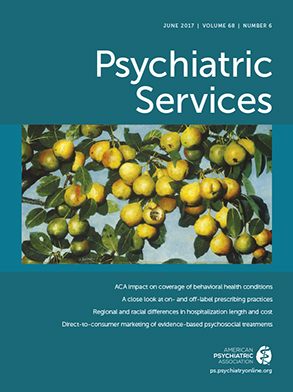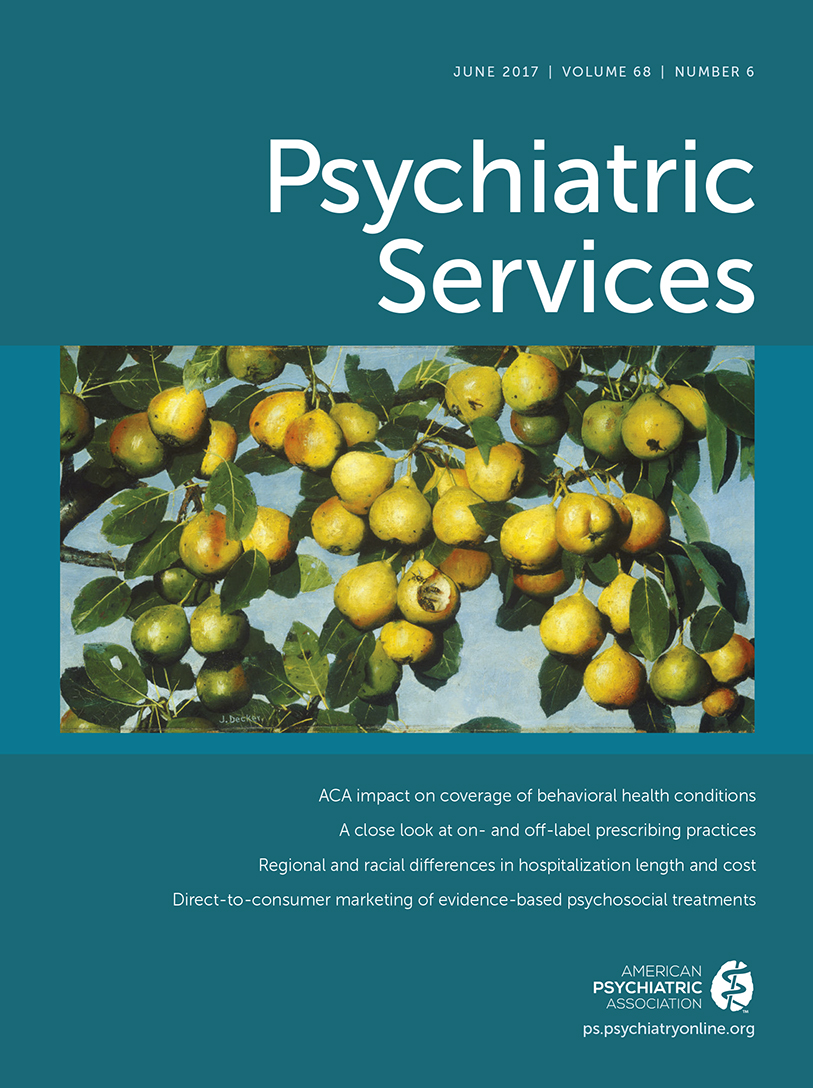Improving coordination of care is associated with reducing inpatient use in favor of outpatient community-based mental health care (
1) and with improved functional outcomes (
2). A first step in establishing continuity of care after discharge from inpatient psychiatric treatment is ensuring that the patient receives outpatient services (
3).
Attendance at the first outpatient mental health visit after inpatient discharge varies widely, depending on the clinic setting and population served. A 1989 study of emergency psychiatric admissions in New York City found that 70% attended the first outpatient appointment (
4); other clinics found rates of 36 to 82% (
5–
7). Several factors may be associated with propensity to keep the first outpatient appointment. Patients may be less likely to keep the first appointment if they are male (
8), Latino (
6), or African American (
7) or if they have co-occurring psychiatric and substance use disorders (
8,
9). Patients may be more likely to keep the first outpatient appointment if they have greater family and social support (
6,
7), are older (
9), and have less than a high school education (
9).
Given the importance of continuity of care (
1), a class-action lawsuit (
Koskinas v. Cuomo) established the right of clients with psychiatric disabilities who are discharged from public psychiatric inpatient units in New York City to receive discharge planning, including housing and outpatient treatment (
10). The first outpatient appointment should occur within seven days of discharge. Hospitals subject to this ruling employ social workers who call providers after the initial appointment date to inquire whether the appointment was kept and follow up with patients who did not attend. This is done regardless of whether the outpatient provider is connected to the hospital system or is located outside the city or state. This study examined attendance rates at the initial outpatient visit after discharge from inpatient treatment at a hospital subject to the
Koskinas ruling, and it examined whether attendance varied among patients discharged from two randomly chosen general psychiatric inpatient units and two specialty psychiatric inpatient units—a unit geared toward persons with co-occurring (dual diagnosis) disorders and a unit geared toward Latino patients.
Methods
A retrospective chart review, compiled from the hospital’s electronic medical record (EMR) and the database maintained by social workers who ensure the hospital’s compliance with Koskinas, was conducted of all patients discharged from January 1, 2007, to December 31, 2008, in the four psychiatric inpatient units. A total of 2,363 discharges were recorded during this two-year period. Of those, 2,277 had information on whether the initial postdischarge outpatient appointment was kept. A total of 393 records were excluded because the clients were transferred to other facilities or left against medical advice and thus did not complete the discharge process. Therefore, 1,884 discharges representing 1,759 unique patients were analyzed. The study was approved by the hospital’s institutional review board.
We examined characteristics associated with attending a first outpatient visit after inpatient discharge in three domains: operational (inpatient unit and receipt of case management), demographic (gender, age, race and ethnicity, preferred language, place of birth, immigration status, insurance status, and housing status), and clinical (presence of a co-occurring substance use disorder and general medical comorbidities, primary psychiatric diagnosis, and length of inpatient stay). The dependent variable (first-visit attendance) was obtained from the records of follow-up calls to outpatient clinics by social workers. Operational, demographic, and clinical variables were collected at the time of discharge in the hospital’s EMR and were entered into the model in a stepwise fashion to see whether the association between unit of treatment and receipt of first outpatient visit varied when these variables were added to the model. Multivariate logistic regression was used, with cluster analysis to account for multiple observations among patients. Analyses were conducted using Stata, version 13.1.
Results
Most clients (N=1,578, 84%) attended the initial outpatient appointment after discharge from an inpatient psychiatric unit. [A table with details on sample characteristics is available as an
online supplement to this report.]
Table 1 shows characteristics associated with attending the initial outpatient appointment. In model 1, patients who received treatment in the dual diagnosis unit had higher odds of attending the first outpatient appointment than did those who were admitted to the general inpatient units (odds ratio [OR]=1.38); no significant association was found for the Latino unit. These associations remained relatively consistent across the four models, as operational, demographic, and clinical variables were included. In model 4, receipt of case management was positively associated with attending the initial appointment (OR=1.53) and non-Latino blacks had lower odds of attending the initial appointment than did non-Latino whites (OR=.57). Compared with those who were domiciled, persons who lived in shelters or who were homeless had higher odds of attending the initial appointment (OR=2.48 and OR=2.04, respectively). Persons with known general medical comorbidities had higher odds of attending the initial appointment, compared with those with no such comorbidities (OR=1.36).
As in the main analyses, the propensity score matching analysis showed that persons served in the dual diagnosis unit had greater odds of attending the initial appointment than did those admitted to the general psychiatric units; in addition, no significant differences were found between those served on the Latino unit and those admitted to the general psychiatric units [see online supplement].
Discussion
The rates of attendance of the initial outpatient appointment (84%) are higher than the 70% rate identified in New York City before the
Koskinas ruling (
4) and are higher than most published literature in other settings. Consistent with prior literature, we found that non-Latino blacks (
7) had lower odds of attending the initial appointment than did non-Latino whites and we found that people who received case management (
6) had higher odds of attending the initial appointment. Some of our results, however, are surprising. Persons with general medical comorbidities had higher odds of attending the initial appointment, which perhaps reflects greater contact with the health care system. Persons who were homeless or who were living in a shelter had increased odds of attending the initial appointment, which contrasts findings from other studies (
3). In this hospital, many homeless patients are discharged to a shelter closely affiliated with the hospital, and many other local shelters have outpatient mental health treatment available on site or through mobile units. Therefore, homeless persons discharged from this hospital may be particularly likely to be connected to outpatient treatment, at least immediately after discharge.
Patients treated in the dual diagnosis unit were more likely than those treated in the general psychiatric units to attend the initial appointment, even after accounting for the propensity of unit assignment (see
online supplement). Although patients with co-occurring disorders generally have lower rates of first-visit attendance (
8,
9), less is known about the impact of parallel and integrated treatments on continuity of care (
11,
12). The dual diagnosis unit at this hospital is a training unit in addiction psychiatry. Thus it is possible that the physicians in this unit who are receiving fellowship training may have been particularly attuned to interactions with patients and families to ensure continuity of care.
Treatment on the Latino unit was not associated with greater attendance at the first outpatient appointment, compared with treatment on the general units. Previous research on ethnically matched inpatient units has provided mixed results. One study found that Latinos and Asians (but not blacks) served on matched units had better referral placement (
13,
14). In this local area, there were limited options for outpatient clinics targeted to the Hispanic/Latino community (
15). These limited options may have made it difficult, for example, for Spanish-speaking patients to receive a referral close to their home or at a preferred time or place. Spanish-speaking patients may also have not followed up on referrals for outpatient treatment if they believed the availability of Spanish-speaking providers was limited. Regardless, the effects of the limited availability of outpatient providers focused on the Hispanic/Latino community would have equally affected persons discharged from the Latino and other inpatient units. This may be one reason why patients discharged from the Latino unit did not have outpatient attendance rates that were significantly different from those discharged from the general units.
Study limitations should be noted. This was a retrospective chart review, so we do not have information on how these patients were assigned to units or how the units communicated discharge instructions. This observational study examined associations only and cannot show causality; comparisons to hospitals not affected by the Koskinas ruling were not made.
Conclusions
Ensuring that patients effectively transition to community-based outpatient services is a key step in ensuring continuity of care after inpatient discharge. Patients at this hospital have a very high rate of attending their first postdischarge appointment. Patients treated on the dual diagnosis unit had a particularly high rate of outpatient attendance, which may reflect the commitment to ensuring continuity of care by a training unit with addiction psychiatry fellows. Other observed findings may also reflect the services available in the hospital and surrounding area. Persons who were homeless or living in shelters had higher rates of attendance, compared with those who were domiciled, possibly because of the mental health services available through the local shelter network. Compared with patients who received inpatient treatment on the general psychiatric units, those served by the Latino unit did not have higher rates of attending the first outpatient appointment. This may reflect the limited availability of language-concordant outpatient services in the local area.
This study’s findings indicate that, to at least some degree, continuity of care and attendance at the first outpatient visit may depend on the hospital’s resources and the availability of services in the local geographical area. Although previous research has shown poorer continuity of care for persons with co-occurring disorders (
8,
9) or for those who are homeless or living in shelters (
3), this study’s findings suggest that if the hospital assigns resources to such patients, the continuity of care may be strong. Correspondingly, the limited outpatient services in the community that are targeted to the Hispanic/Latino community may make it difficult to maintain continuity of care, regardless of the quality of services offered to inpatients. Thus hospital administrators and clinicians who are trying to understand the patient populations that are at risk of poor continuity of care may wish to examine the characteristics of their hospital, patient population, and availability of local outpatient services. Results from this study suggest that the reasons for lack of continuity of care, including first outpatient visit attendance, may be strongly influenced by local conditions.
Acknowledgments
The authors thank Marc Galanter, M.D., Manuel Trujillo, M.D., and Sue Marcus, Ph.D., for consultation and advice and Denise Prieto, B.A., and Peter Lam, M.P.H., for research assistance.

